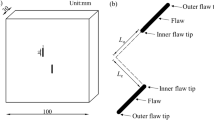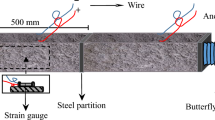Abstract
This paper presents the applications of digital image correlation technique to the mesoscopic damage and fracture study of some granular based composite materials including steelfiber reinforced concrete, sandstone and crystal-polymer composite. The deformation fields of the composite materials resulted from stress localization were obtained by the correlation computation of the surface images with loading steps and thus the related damage prediction and fracture parameters were evaluated. The correlation searching could be performed either directly based on the gray levels of the digital images or from the wavelet transform (WT) coefficients of the transform spectrum. The latter was developed by the authors and showed higher resolution and sensitivity to the singularity detection. Because the displacement components came from the rough surfaces of the composite materials without any coats of gratings or fringes of optical interferometry, both surface profiles and the deformation fields of the composites were visualized which was helpful to compare each other to analyze the damage of those heterogeneous materials.
Similar content being viewed by others
References
Li VC, Maalej M. Toughening in cement based composites, part I.Cement & Concrete Composites, 1996, 18: 223–237
Shah SP, Swartz SE, Ouyang C. Fracture Mechanics of Concrete. New York, Wiley, 1995
Leung CKY, Ubanez N. Pullout of inclined flexible fiber in cementitious composite.ASCE J Engng Mech, 1997, 123: 239–246
Huet C. Coupled size and boundary-condition effects in viscoelastic heterogeneous and composite bodies.Mech of Mater, 1999, 31: 787–829
Anand N, Gu C. Granular materials: constitute equations and strain localization.J Mech Phy Solids, 2000, 48: 1701–1733
Wang JX, Fang J, Karihaloo BL. Asympotic bounds on overall moduli of cracked bodies.Int J Solids Struct, 2000, 37: 6221–6237
Zhang J, Li VC. Effect on inclination angle on fiber rupture load in fiber reinforced cementitious composites.Composite Sci Tech, 2002, 62: 775–781
Shah SP. Application of NDT to basic and applied concrecte research. In: Proc Int Sypm NDT in Civil Engng, Vol. 1, Rotterdam: Balkeman, 1995. 31–38
Fang J. Micromechanics and Contact Problems, Chapter 10. In: Walker CA ed. Handbook of Moire Measurement, Bristoal and Philadelphia: IoP Publishing Ltd., 2004
Mobasher B, Castro-Monotero A, Shah PS. A study of fracture in fiber reinforced cement-based composites using laser holographic interferometry.Exp Mech, 1990, 30: 286–294
Peters WH, Ranson WF. Digital imaging techniques in experimental stress analysis.Opt Eng, 1982, 21: 427–431
Xiong CY. Wavelet analysis for photomechanical image processing. [Ph D Thesis], Beijing: Peking University, May 2000
Fang J, Xiong CY, Yang ZL. Digital transform processing of carrier fringe patterns from speckle-shearing interferometry.J Moden Opt, 2000, 48: 507–520
Surace C, Ruotolo R. Crack detection of a beam using the wavelet transform. In: Proc 12th Int Conf Modal Analysis, Horolulu, Rotterdam: Balkeman, 1994, 1141–1147
Wang Q, Deng X. Damage detection with special wavelet.Int J Solids Structures, 1999, 36: 3443–3468
Carpinteri A, Massabo R. Reversal in failure scaling transition of fiberous composite.J Engng Mech, 1997, 123: 107–114
Li VC, Maalej M. Toughening in cement based composites, part II.Fiber Reinforced Cementitious Composites, 1996, 18: 239–249
Huang JF, Wang ZY, Zhao YH. The development of rock fracture from micro-fracturing to main fracture formation.Int J Rock Mech Sci & Geomech Abstr, 1993, 30: 925–928
Zhao YH, Huang JF, Wang R. SEM study of fracture development in rock materials. In: Mayer Cookm, Goodman Tsing eds. Fractured and Jionted Rock Masses, Rotterdam: Balkman, 1995. 495–499
Author information
Authors and Affiliations
Additional information
The project supported by the National Natural Science Foundation of China (10125211 and 10072002), the Scientific Committee of Yunnan Province for the Program of Steel Fiber Reinforced Concrete, and the Institute of Chemical Materials, CAEP at Mianyang
Rights and permissions
About this article
Cite this article
Jue, Z., Chunyang, X., Hongju, L. et al. Damage and fracture evaluation of granular composite materials by digital image correlation method. Acta Mech Sinica 20, 408–417 (2004). https://doi.org/10.1007/BF02489379
Received:
Revised:
Issue Date:
DOI: https://doi.org/10.1007/BF02489379




